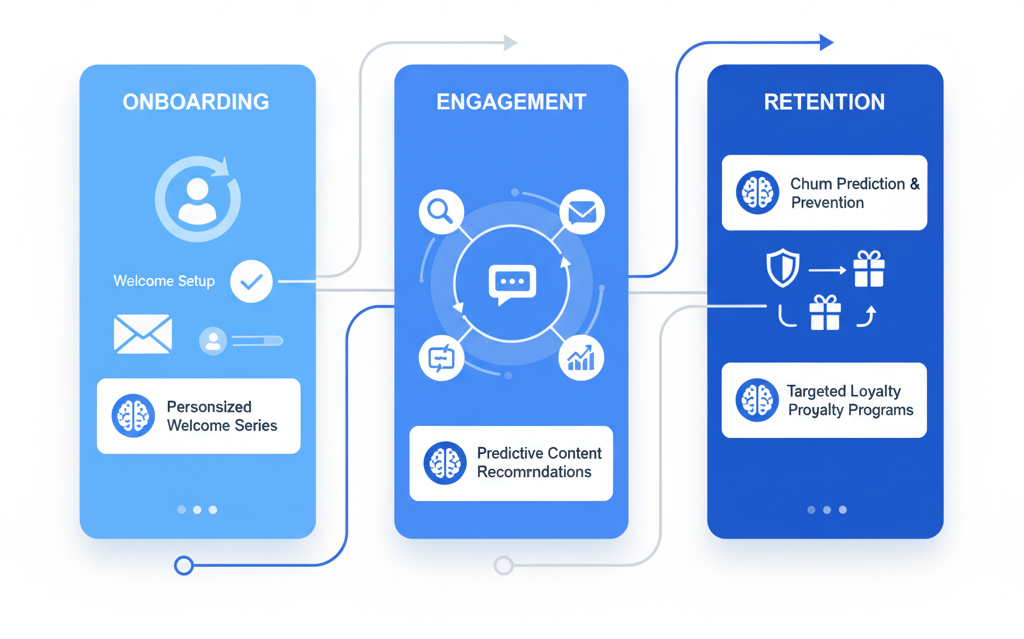
AI Automation in Customer Journeys: From Onboarding to Retention
The Shifting Landscape of Customer Experience
Customer expectations have changed dramatically over the past decade. People now expect immediate responses, personalized interactions, and seamless experiences across every touchpoint with a business. Meeting these expectations manually has become nearly impossible for most organizations, particularly those experiencing growth or operating with limited resources.
Artificial intelligence automation has emerged as a practical solution to this challenge. When implemented thoughtfully, automated systems can deliver consistent, personalized experiences at scale while freeing human teams to focus on complex situations that genuinely require personal attention.
Understanding the Complete Customer Journey
The customer journey encompasses every interaction someone has with a business, from initial awareness through purchase and into ongoing use of a product or service. Each stage presents distinct challenges and opportunities for automation.
Traditional approaches treated these stages as separate functions managed by different teams with different tools. This fragmentation created gaps where customers fell through the cracks or received inconsistent experiences. Modern AI automation connects these stages into a coherent journey where information flows naturally and actions trigger appropriate responses.
Automating the Onboarding Experience
First impressions matter considerably in customer relationships. The onboarding phase determines whether new customers feel confident and capable or confused and frustrated. Automation can ensure that every customer receives the guidance they need precisely when they need it.
Intelligent onboarding systems track user behavior and adapt their approach accordingly. If someone completes initial setup quickly, the system moves them forward to more advanced features. If someone hesitates or makes errors, the automation provides additional support without waiting for them to request help.
An AI automation agency working with a software company might implement progressive onboarding that introduces features gradually rather than overwhelming new users with everything at once. The system monitors engagement patterns and adjusts the pace based on individual user readiness.
Product Siddha has worked with clients to design onboarding automation that reduces time-to-value while maintaining a personal feel. These systems send timely messages, provide contextual help, and escalate to human support only when automated assistance proves insufficient.
Key Onboarding Automation Touchpoints
| Stage | Automated Action | Expected Outcome |
|---|---|---|
| Account Creation | Welcome email with next steps | Clear direction, reduced confusion |
| Initial Setup | Progressive tutorials based on user role | Faster completion, higher confidence |
| First Use | Contextual tips triggered by actions | Improved feature adoption |
| Completion | Congratulations message with advanced resources | Sense of achievement, continued engagement |
Intelligent Engagement During Active Use
Once customers complete onboarding, the focus shifts to supporting their ongoing success. This middle phase of the customer journey often receives less attention than acquisition or onboarding, yet it critically influences retention and expansion opportunities.
Automation during active use should feel helpful rather than intrusive. Systems can monitor usage patterns to identify when customers might benefit from learning about additional features, when they appear stuck on a task, or when their engagement drops below healthy levels.
Behavioral triggers allow automation to respond to what customers actually do rather than following rigid schedules. If someone repeatedly performs a task manually that could be automated within the product, the system might suggest the more efficient approach. If usage suddenly decreases, automation can reach out to understand whether the customer encountered problems or simply has seasonal usage patterns.
Predictive Automation for Retention
Preventing customer churn proves far more cost-effective than acquiring replacement customers. AI automation excels at identifying early warning signs that someone may be considering leaving and triggering appropriate interventions.
Predictive models analyze dozens of behavioral signals to calculate churn risk for individual customers. These models consider factors like login frequency, feature usage depth, support ticket patterns, and payment history. When risk scores cross certain thresholds, automation initiates retention workflows tailored to the specific situation.
An AI automation agency implementing retention systems might create different intervention paths based on why someone appears at risk. Technical problems trigger offers of additional support or training. Pricing concerns might prompt conversations about value received or alternative plans. Competitive pressure could activate campaigns highlighting unique capabilities.
The key lies in matching the response to the actual situation rather than applying generic retention tactics uniformly. Automation makes this level of personalization achievable at scale.
Renewal and Expansion Automation
For subscription businesses, the renewal period represents a critical moment in the customer journey. Automation can ensure that renewals happen smoothly while identifying opportunities for expansion into higher tiers or additional products.
Well-designed renewal automation begins engaging customers well before contracts expire. It highlights value received during the current period, addresses any outstanding concerns, and makes the renewal process as frictionless as possible. For customers showing strong engagement and growth, automation can identify the right moment to discuss expansion opportunities.
This approach requires sophisticated data integration. The automation must understand usage patterns, support history, payment behavior, and business outcomes to make intelligent recommendations about timing and messaging.
Human-AI Collaboration in Customer Success
Effective automation does not replace human involvement in customer relationships. Instead, it amplifies what human teams can accomplish by handling routine interactions and flagging situations that benefit from personal attention.
Customer success teams working alongside automation systems can focus their time on strategic planning, relationship building, and complex problem-solving. The automation handles monitoring, routine communication, and data analysis that would otherwise consume most of their capacity.
Product Siddha approaches AI automation implementation with this collaborative model in mind. The goal involves creating systems that make human team members more effective rather than simply reducing headcount. This philosophy produces better customer outcomes and more sustainable operations.
Implementation Considerations
Organizations considering AI automation for customer journeys should start with clear objectives and realistic timelines. Attempting to automate everything simultaneously typically produces poor results. A phased approach that tackles one journey stage at a time allows for learning and refinement.
Data quality determines automation effectiveness. Systems can only personalize experiences and make intelligent decisions when they have access to accurate, complete information about customers and their interactions. Many organizations discover they need to improve data collection and integration before automation can deliver its full potential.
Integration between systems presents another common challenge. Customer journey automation requires connecting marketing platforms, product analytics, support systems, payment processors, and other tools. An experienced AI automation agency can navigate these technical challenges and ensure smooth data flow across the entire technology stack.
Measuring Automation Success
Clear metrics help organizations understand whether their automation investments produce desired results. Different journey stages require different measurements, but some universal indicators include response time to customer actions, completion rates for key processes, time-to-value for new customers, and overall retention rates.
Beyond these operational metrics, customer satisfaction scores provide important feedback about whether automation enhances or detracts from the experience. Regular surveys and feedback collection help identify where automation works well and where adjustments are needed.
Building Sustainable Customer Relationships
AI automation has matured from a novel experiment into a practical tool for managing customer relationships at scale. Organizations that implement automation thoughtfully across the entire customer journey create experiences that feel both efficient and personal.
The most successful implementations balance automation with human touch, use data intelligently without becoming intrusive, and constantly refine their approaches based on results. Working with specialists who understand both the technical and strategic aspects of automation helps organizations avoid common pitfalls and achieve results faster.
Product Siddha continues to help businesses design and implement AI automation that strengthens customer relationships rather than mechanizing them. The focus remains on creating genuine value for customers while building operationally sustainable businesses that can grow without proportionally expanding overhead.
